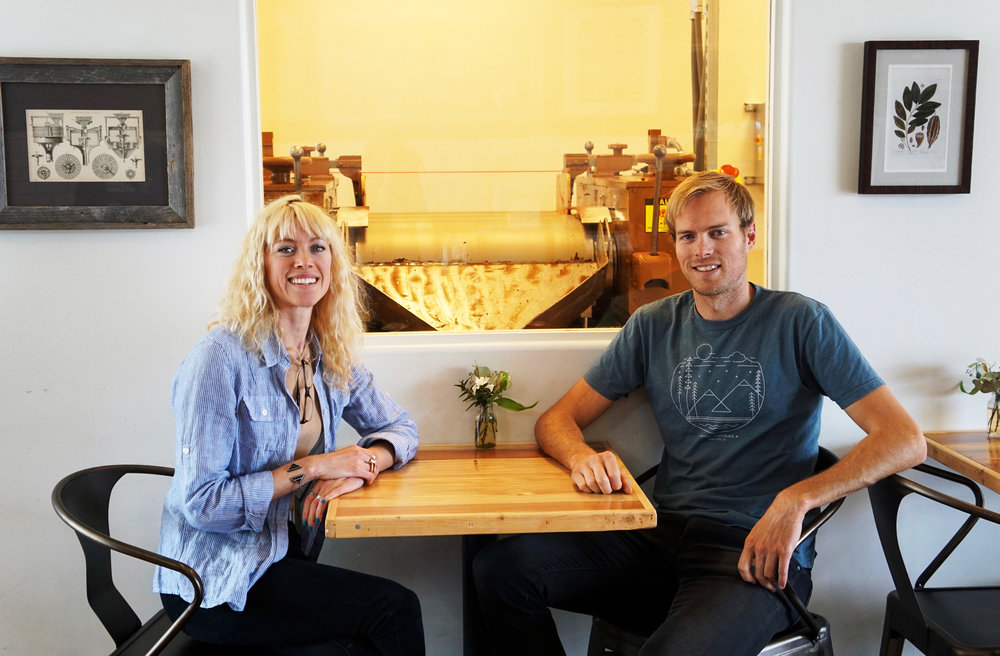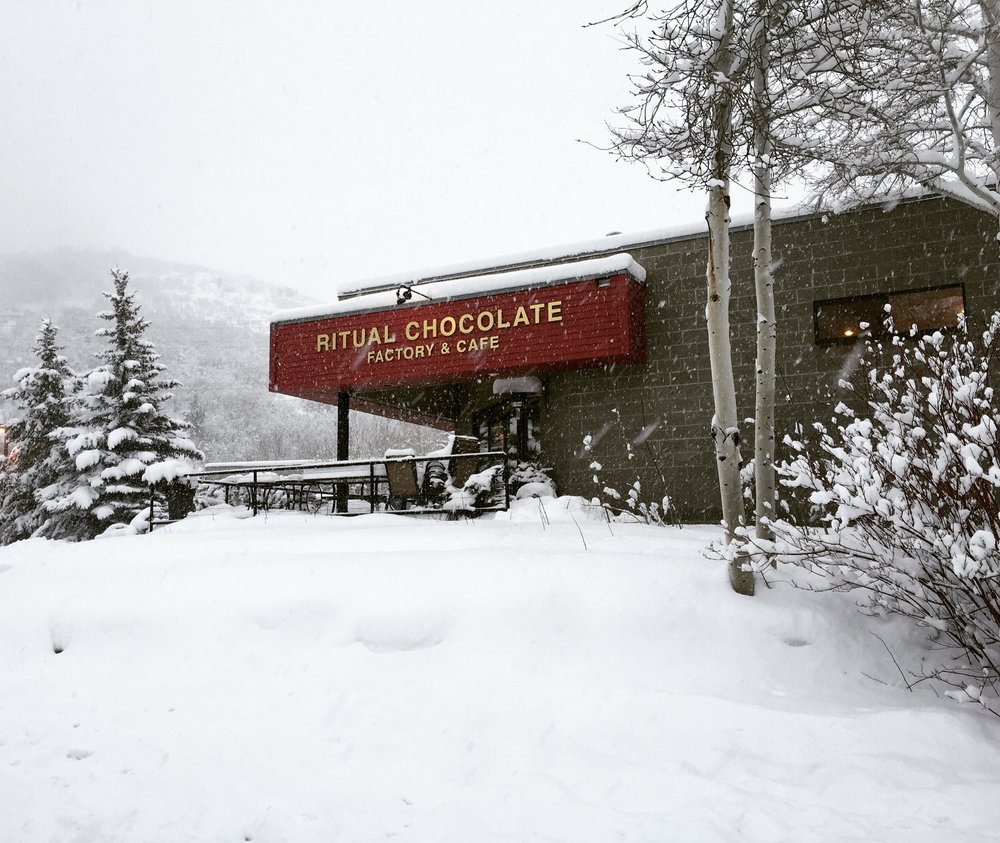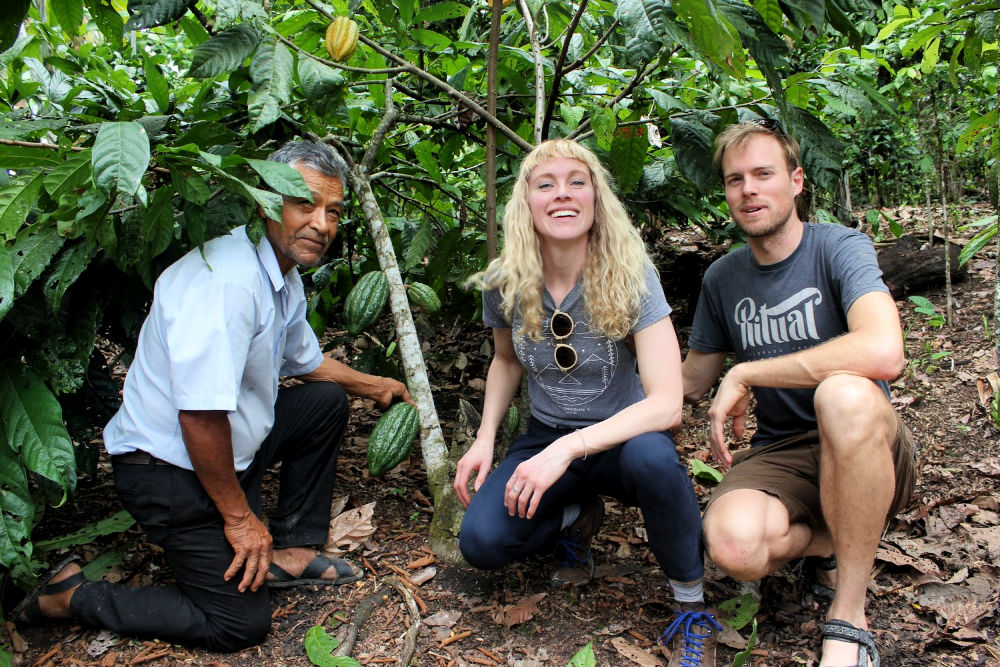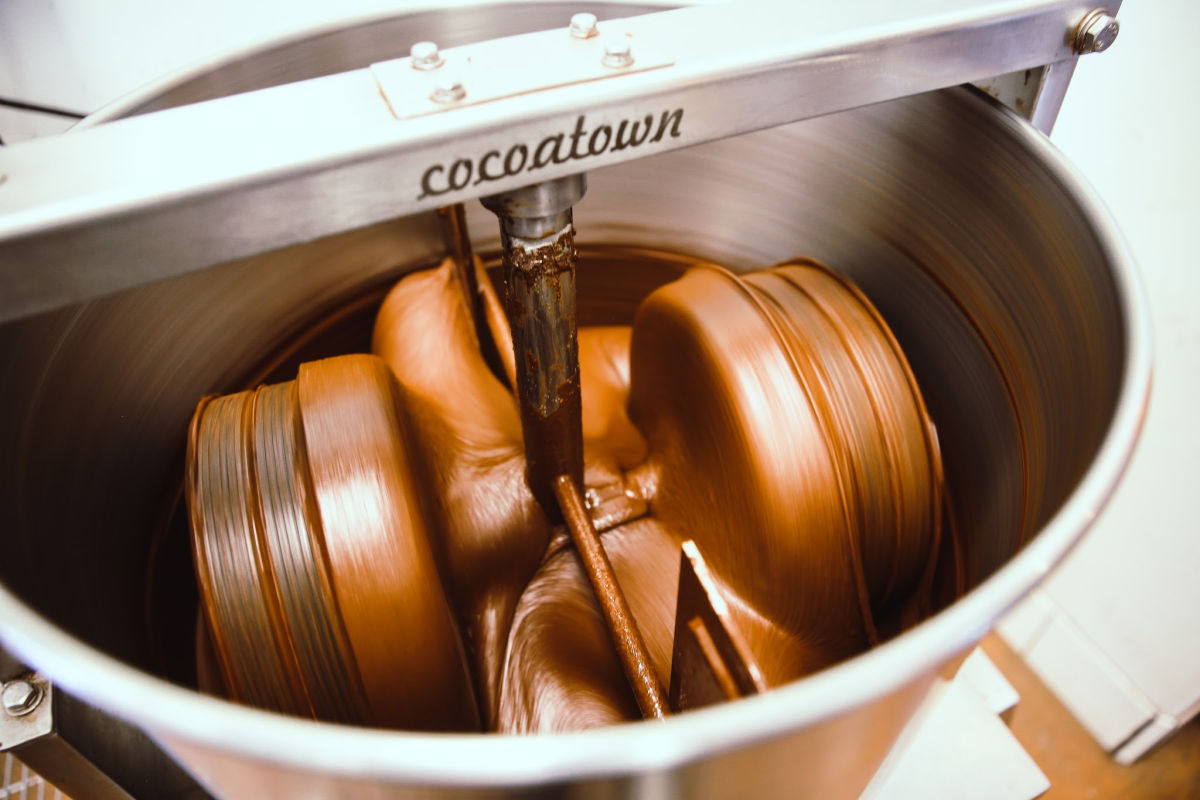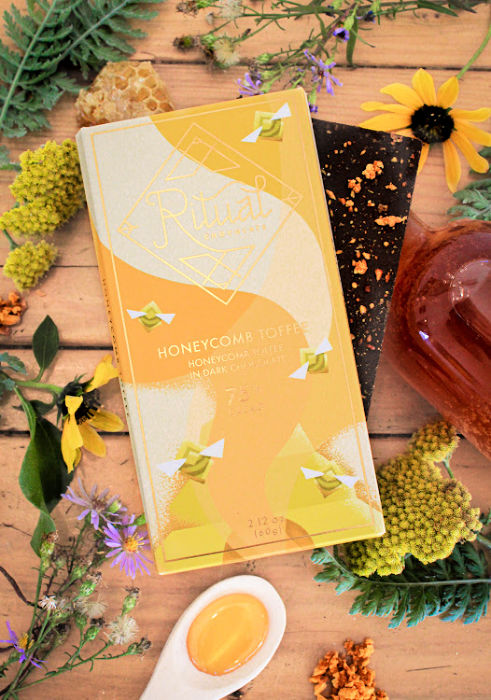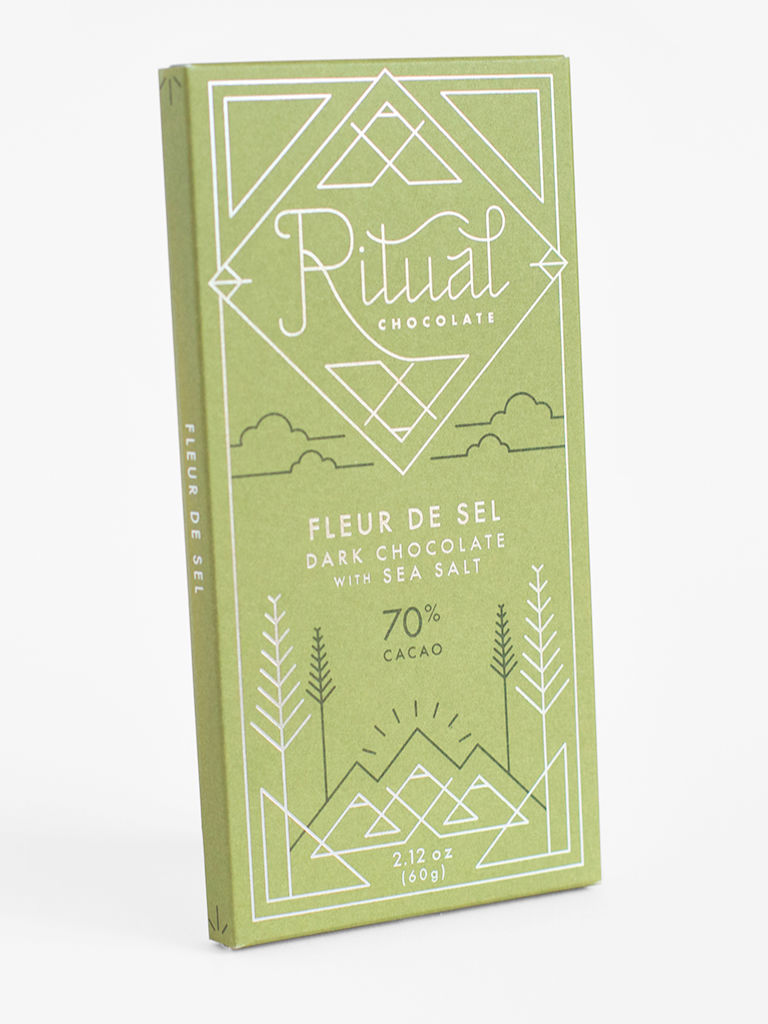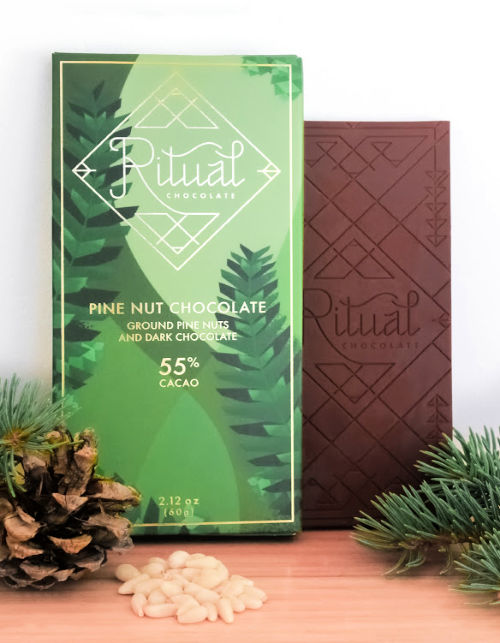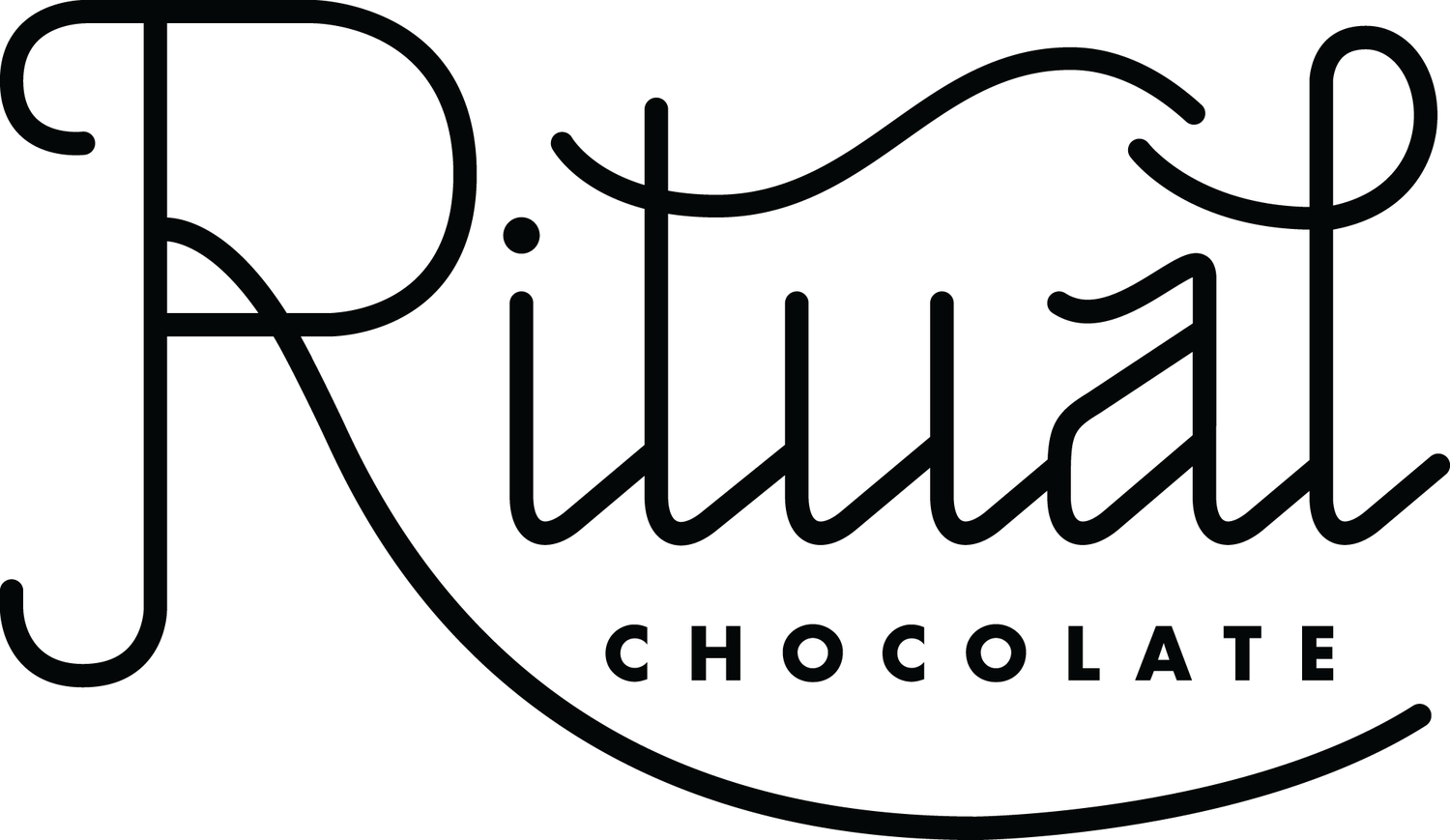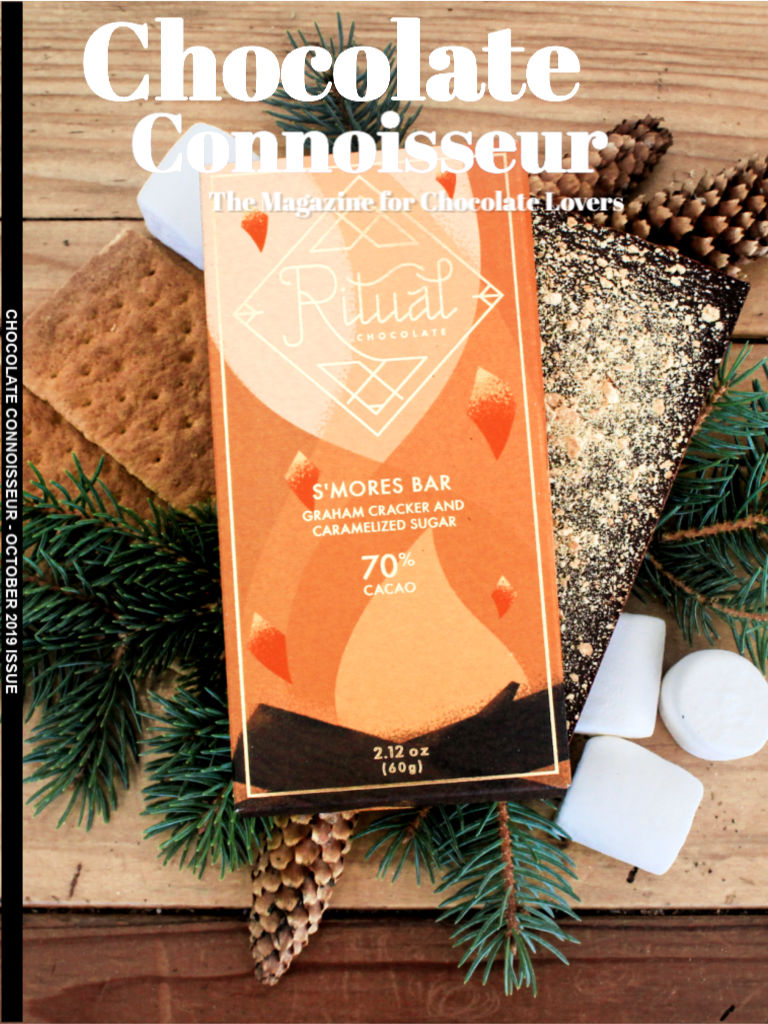In Focus:
Ritual Chocolate
by Eric Battersby
As a filmmaker, when I think of Park City, Utah, my thoughts jump right to the Sundance Film Festival of course, especially since I remember multiple years grinding away to make a submission deadline for the king of the independent film world.
When I put on my chocolate connoisseur cap, however, those Park City thoughts quickly shift to a modest chocolate factory and café comfortably nestled amongst the city’s majestic, panoramic mountains.
Fellow chocolate lovers, welcome to Ritual Chocolate, where the spectacular scenery only enhances the outstanding bean-to-bar chocolate crafted by the business partner duo Robbie Stout and Anna Davies for your tasting pleasure.
Anna and Robbie underwent quite an exhilarating, albeit grueling, chocolate adventure to reach the top of their chocolate mountain, way up between the other peaks of Utah’s high country. Today, you’ll join them on that journey.
Let’s take the first step…
Chocolate in the Dark
In a very rare case (since most chocolate makers we profile tend to discover dark chocolate later in life), Anna and Robbie both always loved dark chocolate — even more than any dessert — as far back as they can remember. Despite enjoying chocolate “fairly religiously,” as Robbie notes, they still knew very little about it, even right before they started their own company —
“It wasn’t until we both were gradually becoming foodies that it caught our attention as something interesting and not just tasty.”
In 2009, although they knew they wanted to start a business together, nothing sounded particularly exciting at the time… until fate finally intervened.
Anna and Robbie randomly did a bit of an at-home chocolate tasting with Anna’s brother, and something about tasting chocolate in such a structured manner lit a light bulb.
They suddenly realized that they knew almost nothing about this food they ate so frequently (they called eating chocolate after dinner each night their “ritual”).
Indeed, as Robbie reflects back on it now –
“Not only did we know nothing about it, everything we thought we knew about it was mostly wrong. So we began researching all things chocolate.”
As the duo dug their heels in to explore the chocolate world, a few realizations utterly shocked them –
“First, a lot of chocolate brands don’t actually make the chocolate they sell — they buy it from larger chocolate makers.
Second, most chocolate sold as “high end” is almost entirely marketing and not actually any better than the rest.
And third, the supply chain model for cacao is broken (no rewards for high quality and the prices are too low).”
From that point in 2009, carrying over into 2010 (all while still living in Colorado, by the way), Robbie and Anna started to formulate their own chocolate business.
An Up-Mountain Battle
As excited as they were to start a chocolate company, Anna and Robbie also realized that chocolate required a hefty amount of capital to get started, and they truly had nothing at the time –
“When you’re living from paycheck to paycheck and your account hits close to $0 almost every week, a chocolate factory is not an easy business to start. With every penny we did have, we felt that immersing ourselves in cacao growing culture was the most important thing we could do at the time.”
So they planned a 3-week trip to Costa Rica, set to visit different cacao farms and go hands-on with their chocolate dream. On that Costa Rican adventure, they found a new level of resolve.
Anna shares one particularly memorable story —
“The first cacao farm we set foot on was in Costa Rica in 2008. It was Hugo Hermelink’s FINMAC farm near Villafranca, in the north central region that spanned 110 hectares.
As we walked among the carefully tended cacao trees, we saw numerous sloths sitting in the trees, a caimin alligator in a nearby stream, and a cacophony of insects and birds.
It was a true ecosystem, and it really hit home for us that cacao needs to be in a healthy forest which is bio-diverse, with nutrient-rich soil and a thriving insect population.
Cacao farms are also biological corridors for larger predators such as big cats to roam and hunt. We felt that cacao was a product we could feel proud to source, as it was good for the habitat and needs that rainforest ecosystem to thrive. This is why we started putting animals on our packaging.
Our first bar was our Costa Rica 75% with a sloth drawing on the front. FINMAC was considered a sloth sanctuary with over 70 sloths residing on the farm. And this was in stark contrast to the neighboring pineapple and banana plantations that had no wildlife to speak of.”
Needless to say, the lengthy trip worked, and when they returned, a new level of excitement to launch their chocolate business took a hold.
Anna Davies and Robbie Stout in their Ritual Chocolate Cafe
Unfortunately, taking a trip to Costa Rica certainly didn’t resolve the financial situation confronting Anna and Robbie. The money equation still didn’t add up.
A new level of determination, however, meant nothing would stand in their way. They sold a few things, including a drum set and bass guitar (say it ain’t so!), pulling together the funds to buy and build some at-home chocolate-making equipment. Then, in that first year, Robbie and Anna almost exclusively used the cacao they brought back from Costa Rica to make chocolate.
Still, an initial burst of determination and energy only carries a business so far, as nearly every entrepreneur, including yours truly, will attest to. The long haul requires a level of resolve few can muster, as Robbie notes here —
“By August, it was clear we had no chance of starting anything without more money. So we came up with the idea to start a side business and to put all that money towards the chocolate business.
At the very beginning of September, we formed the business that became Ritual Chocolate, but under a different name back then — Chocolate BAAR (for “Chocolate by Anna and Robbie”).
Our side hustle was a traveling Belgian waffle stand we set up at local cyclocross races. Every weekend when we weren’t at our regular jobs, we set up a small waffle stand at bike races all around Colorado.
It was a lot of work and we didn’t pay ourselves, but we did actually raise a few thousand dollars, and we learned a lot about business basics along the way. Between the waffle stand and a three thousand dollar business grant from Boulder City, we had some money in the bank.”
Still, they both knew a grind awaited them. Thankfully, another twist of fate shifted their chocolate journey, courtesy of a connection with Steve DeVries. They spent a week with Steve back in Costa Rica, but in late 2010 they reconnected and started buying Costa Rican cacao from him.
As they searched for a way to build a chocolate factory in Boulder, with little progress to speak of, that’s when the chocolate gods once again intervened. Seemingly out of the blue, Steve offered a chance to rent his factory which, at the time, was no longer in full production.
Robbie reflects on the serendipitous offer —
“How many chocolate factories in the world could there have been that were not really being used and available for rent? Probably one. That one. And it was only thirty miles away from us.
Even though most aspects of our business weren’t in order yet, we immediately jumped on the opportunity and started paying rent on January 1, 2011.
We spent the next six months making batches of chocolate and racking up credit card debt. We had no aspects of our brand design worked out… we didn’t even know what our brand even really was at the time.
Yes, we knew it would be Ritual. We also knew we wanted to source top quality cacao, and that now, with access to nice chocolate-making equipment, we wanted to make the best chocolate in the world… but that was about it.”
With a newly invigorated feeling of destiny fueling the fire, Anna and Robbie finally started by selling chocolate discs in glass jars at coffee shops. They felt it was the easiest way to get people trying their chocolate, at just $1 per disc. Back then, at least in Colorado, the $10 dollar chocolate bar didn’t really exist.
In the summer of 2011, the duo found chocolate molds online for only $2 each, and prepared to take things up a notch. They designed the label themselves, and initially they even printed and cut the labels at home, before shifting the arduous cutting work to Kinkos (now known only as FedEx Office).
Robbie reflects back on those early days –
“For that first year I remember dropping off stacks of printed labels from our house and paying probably more than we should have to have Kinkos cut them. That was a regular chore for us—a trip to Kinkos.
So it all started right about there — renting Steve’s factory, making our chocolate by hand, and approaching local stores to carry us. Money was really tight for quite some time. We kept our day jobs throughout, and 18-hour days were a regular occurrence. I remember we used to joke that we were yet again having another 100-hour work week. Work was literally non-stop.
All of our old hobbies disappeared. We didn’t get paid for the first few years. Even when we started getting paid, it was an ongoing joke that we were earning maybe $1 per hour… or that no matter what other job we’d take, we’d be getting paid more because back then minimum wage was around $7.50 (which sounded luxurious at the time)!”
The entrepreneurial chocolate grind truly set in, as month after month, year after year, Anna and Robbie diligently kept plugging away, making chocolate every day of the week, making small improvements, gaining new accounts all the time, and hitting new milestones on a regular basis.
Each new milestone fueled the fire.
Finally, in 2014, Ritual’s business brought in roughly two hundred thousand dollars, which essentially meant a production level of 50,000 chocolate bars!
With that milestone achieved, Anna and Robbie decided they needed to make another significant change — living in the mountains, living close to nature. Robbie explains –
“We found that while having regular 100-hour work weeks, it was impossible to find any time to drive from Denver to the mountains to get some fresh air. The only way to make that possible would be to work where we wanted to play.”
In February of 2015, Anna and Robbie closed their Denver factory and opened a new one in Park City, Utah that March.
The 100-hour work weeks continued for a while, especially during the factory build out, but eventually the hard-working duo found time to get outside again… to recover physically and emotionally from the stress of the incredibly grueling run as they created their hands-on manufacturing business.
Robbie fondly remembers the first moment of freedom —
“I’ll probably never forget the first mountain bike ride I took right after the snow melted in April — that was about five years overdue!”
I even felt a sense of relief simply as a writer telling their story, so I can’t imagine how incredible it felt for Anna and Robbie to finally hit the peak they longed to reach for several years running.
Since the new factory opened, Anna and Robbie constantly search for new ways to improve their process, from using their 1950s 3 roll mill and their 1915 Swiss longitudinal conche.
Robbie adds —
“We’ve found ways to improve all of our origins, so even though we are a lot bigger than we used to be, our process is better too, so our chocolate is the best it’s ever been.
Now we just want to continue improving all aspects of our business… to continue making great chocolate while developing new products unique to the Ritual brand.”
Cacao Bonding
Regardless of all the difficult obstacles overcome… the trials and tribulations fought through to finally reach such success… no great chocolate comes to fruition without stellar cacao, and no stellar cacao exists without some outstanding farmers kickstarting the entire process.
Robbie and Anna learned that lesson very early in the game.
“We’re just really happy with all of our growers. Every farm and cooperative we work with is setting the bar for the highest standards in the environmental, flavor, economic, and social aspects of cacao.
We only want to work with origins that we can feel good about and that challenge the old models.”
With many visits to family farms within the different origin countries they selected for their chocolate, Anna and Robbie certainly experienced their share of adventure across the cacao belt.
One of their favorite aspects of these trips to family farms is the occasional family lunch. In Peru and in Belize, they enjoyed several home-cooked farmhouse lunches with families.
Anna and Robbie will happily tell you that such meals “are the best lunches we’ve had anywhere in the world, and the best food. There’s something extra tasty about fresh ingredients, local spices, and old styles of preparation.”
Not surprisingly, they consider those wonderful meals to be the highlight of each trip abroad. When a farmer graciously invites you into their family’s home and then serves fresh food that’s grown and raised on their own farm, well… what’s not to love?!
The chocolate duo relays one particularly memorable story from an origin trip —
“We once hiked out to a farm in Peru, only accessible by foot through a thick forest. The farm sat on top of a hillside, where we were greeted by barking dogs and chickens clucking all around our feet.
The farmer’s wife greeted us with a big smile and showed us around their property, bursting with such a diverse mix of crops including corn, banana trees and cacao.
For lunch we were welcomed into their small wooden house with wonderful smells from a wood burning stove.
The meal was simple, yet so flavorful and delicious… made up of chicken, corn, yuka, chillies, and rice. We were served a traditional hot chocolate drink, right where the cacao beans are roasted, shelled, ground down, and mixed into water with sugar.
At the end of the meal, we tried some honey from the hives on the farm.
It’s during these meals that you get an opportunity to really connect with the farmers… to learn more about their culture. Even though a language barrier exists, there is something about sitting down to a meal together, about being invited into a farmer’s home, that really connects you.”
For Ritual’s part, with every lunch they partake in, Anna and Robbie love to give the family some chocolate bars they crafted with those exact cacao beans, since it’s sadly so seldom that farmers ever get to see or taste a finished chocolate their harvested cacao produced.
Ritual Process
Of course, the home stretch of great chocolate production happens not on the farm, but in the factory, and with no professional training, Anna and Robbie had a steep learning curve to overcome on that front as well. For the most part, they are self-taught chocolate makers who learned largely “by osmosis”, from working with Steve DeVries and getting tips on how to use the equipment.
The process Robbie and Anna developed over the years is now really a part of Ritual’s magic. It helps set them apart from many other chocolate makers.
Robbie elaborates –
“We have a very unique approach to grinding, milling and conching, one that I’ve never seen anywhere at this level.
If you include our conche, we have a 4-step milling process. We use a grist mill to grind the nibs, Cocoatowns to grind and mix the nib paste and sugar together; then a 1950s 3-roll mill to get our chocolate ultra fine… and three full days in our 1915 Swiss longitudinal conche.
We are really obsessed with texture and all of these steps help achieve an ultra-smooth chocolate with tons of flavor.
And of course, all of our flavor comes from the particular origins we work with. A lot of other makers work with these origins, but none are doing it with our process.”
Ritual sources their cacao from Belize, Madagascar, Peru, Ecuador, and Mexico. All of their own ingredients are grown organically, and by mid-year 2020, Robbie pledges that all of the ingredients they use from anywhere will be certified organic as well. Ritual’s bars are already vegan.
Of the utmost importance, Robbie makes one more chocolate promise as well –
“We also guarantee that our cacao is grown responsibly from an environmental standpoint, and that labor practices are all good for everyone involved.”
One final Ritual-specific note – they craft their Mid Mountain blend with a blend of four different origins, which, as Robbie notes, “We’re pretty sure isn’t being blended in that way by any other makers.”
“It’s really an amazing balanced chocolate,” he adds.
That sounds like a challenge to me, so now that we know how Ritual came to be, let’s finally dive into the chocolate itself.
Ritual Chocolate’s New Mountain Line
Award-Winning Chocolate Bars, High Quality Ingredients
Ritual currently offers a whopping seventeen different bars, many of which offer rather unique flavor profiles you likely won’t find anywhere else. This hefty count includes their new Utah mountains-inspired bars, aptly called the “Mountain Line,” for which Ritual either sources ingredients locally, or, if sourced otherwise, the company draws inspiration from their high desert, alpine surroundings.
This new Mountain Line includes four beautifully-packaged bars:
- 75% Dark Honeycomb Toffee Bar (Belize)
- 55% Dark Pine Nut Chocolate Bar (Dark Chocolate Blend)
- 70% Dark S’mores Bar
- 70% Dark Juniper Lavender Chocolate Bar (Mid Mountain Blend)
In addition to the new line, Ritual sent us their most award-winning bar to date, the 70% Dark Fleur de Sel Bar, also made with their Mid Mountain Blend chocolate, and then their 75% Dark Belize Bar, another award-winner as well.
Although they didn’t send us this bar, it’s also worth mentioning their #1 bestseller, the very unique 70% Dark Mid Mountain Blend Bar, whose cacao blend makes its way into multiple other bars as well. As Robbie notes –
“I think it is our best seller because it has the most unique flavor. It’s a combination of four different origins. Not only is the flavor great, but at 70% (instead of any higher) it’s approachable even to people who aren’t into dark chocolate. People also seem to love the name and design of the bar.”
Speaking of design, Ritual also won an Academy of Chocolate Awards Silver Award for their packaging, which, as you’ll see throughout here, colorfully grabs your attention with an artistic, yet very clean, design.
I’m currently surrounded by all six of the bars Ritual sent us, and I honestly can’t take it anymore… it’s time to taste some chocolate!!!
75% Dark Honeycomb Toffee (Belize)
First, I’ll start with the Honeycomb Toffee Bar. Part of the new Mountain line, Ritual uses local, raw honey, sourced from hives around the Wasatch mountain range, for the bar’s toffee. As Robbie mentions, “It’s lightly-sprinkled into our Belize 75% chocolate giving a sweet, honey crunch.”
One thing you’ll notice immediately upon ripping open any Ritual bar, Anna and Robbie have positively mastered texture.
Each piece you break off to enjoy snaps perfectly, and gently pops as you take a subtle bite into it as well. This bar, with a core tasting note of honeycomb, wowed me.
As a little disclaimer, however, I love honeycomb toffee, so this isn’t really a fair fight.
Still, crafting such perfection with only organic cacao, organic cane sugar, and honeycomb toffee (also made with organic cane sugar by the way) can’t be easy, and Ritual has crafted quite the amazing chocolate treat here.
In addition to the obvious honeycomb flavor, the bar also bursts with a sweet floral note I can’t quite place but absolutely adore.
It’s likely a result of the raw honey combined with the Belize cacao (again, another personal favorite), and right out of the gate here, I’m extremely enthusiastic about Ritual… and these other five bars staring me down here.
70% Dark Juniper Lavender
(Mid Mountain Blend)
Next up, since my taste buds are already a flutter with the Honeycomb bar’s secondary floral notes, the Juniper Lavender bar sports notes of lavender, juniper, pine, citrus and floral as well, hopefully a perfect follow up.
When you first open this bar, take a moment to simply enjoy the relaxing waft of lavender emanating from within. With that scent of lavender still in the air, snap off a small piece and dive into the moment. If this is your first taste of Ritual’s unique Mid Mountain cacao blend, it will indelibly leave its mark. Dried juniper berries and culinary lavender… what a delicious bar, and one that’s likely perfect for spring.
As Ritual notes on the packaging, the bar gives —
“…a floral, aromatic finish that lingers on the tongue and conjures up the scent of a high mountain meadow. Best enjoyed with a good friend, good laughs, and a gin and tonic.”
Two for two, Ritual. Two for two.
70% Dark Fleur de Sel Bar
For a change of pace, it’s time to switch over to Ritual’s top award-winning bar, the Fleur de Sel. The fun suggestion inside its pretty green packaging sets the stage –
“Best enjoyed with your favorite Pinot Noir while watching the sun set.”
You had me at Pinot Noir, but let’s dive in.
Ritual suggests the unusual tasting notes combination of strawberry, fudge, and sea salt, which I admittedly did not expect from reading the bars ingredients first (cacao, cane sugar, cocoa butter and fleur de sel).
First things first, although you should of course expect a salty bar (I mean c’mon now, it’s in the title), you’ll likely need to hold the salt and chocolate combination in the utmost esteem to deeply enjoy this bar. To say salt dominates the flavor is an understatement.
Now if you’re a frequent Chocolate Connoisseur reader, you know that a lot of salt just isn’t my thing when it comes to chocolate tastings, so, pun intended, feel free to take this all with a grain of salt (after all, the bar crushes it with multiple awards).
We always make it a point here at the magazine to hit home the point of taste subjectivity in chocolate, so outside of bad ingredients or just a low quality bar, to each his own.
For me, the only note I could pick up in this bar was salt.
Don’t get me wrong though, I still enjoyed the bar — it’s just not my go-to. I’d love it as a light snack with just a quick bite or two, however.
70% Dark S’mores Bar
Switching gears yet again, next is the S’mores bar from Ritual’s new Mountain Line. Showcasing a much larger ingredients list than the rest of the sample bars here, the S’mores bar offers a more complex experience.
With documented tasting notes of graham cracker and caramelized sugar, this bar admirably attempts to replicate those warm and cozy chocolate, graham cracker, and marshmallow moments around the campfire.
It’s a very tasty bar, although for me, I don’t sense much of the expected marshmallow flavor. As for the aforementioned tasting notes, for my tastes they are spot on, perfectly matched. I do thoroughly enjoy this bar’s flavors, but it does leave a bit of a strong aftertaste that the other bars do not.
Still, if you’re a s’mores fan, I can’t imagine you won’t like Ritual’s S’mores Bar.
55% Dark Pine Nut Chocolate Bar (Dark Chocolate Blend)
Finishing off the new Mountain Line, here’s the smoothest of the four bars, the Pine Nut Chocolate bar, with fun tasting notes of “nutty, pine-y, earthy”. At a lower cacao content, the Pine Nut bar initially surprises with a lack of snap when you break off a bite.
You’ll be even more surprised, however, with your first taste.
Oh. My. God.
Ritual’s Pine Nut Bar tastes like no other chocolate I’ve ever tried before. First, it’s incredibly smooth, to a level that completely betrays a 55% dark bar because it not only offers a milk chocolate-esque experience, it does so while staying vegan.
Unbelievable. This bar outduels my own sweet spot, taking down the Honeycomb Bar as my favorite of all Ritual’s fantastic chocolate options.
The tasting notes are spot on once again, although I’d also include hints of sweet cream as well – perfect if you love that taste, and even more perfect if you love that taste and you’re also vegan. Wow, what an incredible chocolate bar.
75% Dark Belize Bar
Potentially saving the best for last here (my all-time favorite chocolate bar comes from Belize cacao), it’s time to taste the final Ritual Chocolate bar, their 75% Dark Belize bar.
With notes of dried fig, cherry, and tobacco (whoa, didn’t see that coming), expect yet another very unique chocolate bar experience.
Here’s Ritual’s short paragraph inside the packaging –
“Made with organic cacao that is grown by a network of Mayan farmers in the Toledo district of Belize. This area has a rich genetic history that is a blend of indigenous heirloom and Trinitario cacao.”
My Belize love has me wanting to be all in on this bar, but first, it’s time to address the tobacco surprise.
Although I do occasionally enjoy a fine cigar (once a year maybe, if that), tobacco certainly doesn’t sit on my favorite tasting notes list… well, on any tasting notes list.
Dried fig? Most certainly. Cherry? You know it.
Tobacco? Not so much.
This perfectly highlights why we adore craft chocolate, and why we even more so should adore the chocolate makers who push the envelope when it comes to cacao… to unlocking the flavors within each origin.
The nose of this bar hits strongly with cherry and fig, and as it smoothly fades away, amazingly to me, an exquisitely subtle tobacco note then finishes off the tasting.
I never expected that to work in a chocolate bar, at least not to the masterful extent it does here, yet it most certainly does.
If the fig and cherry notes entice you to try this bar, but you’re uncertain after seeing the word “tobacco” on the packaging, don’t sweat it. I’ll say it again — the tobacco note is very subtle, and it perfectly finishes this bar, so I wholeheartedly encourage you to give Ritual’s Belize bar a try.
Other Bars from Ritual
Although we didn’t get the chance to sample it, Ritual’s 75% Dark Peru chocolate bar holds a special place in the hearts of Anna and Robbie, and would definitely be next on our list of Ritual Chocolate to try.
Robbie shares the backstory –
“We had the opportunity to try chocolate made with Maranon Cacao beans back before we even started Ritual. Steve DeVries made the chocolate, and we tasted it while on a trip to Costa Rica.
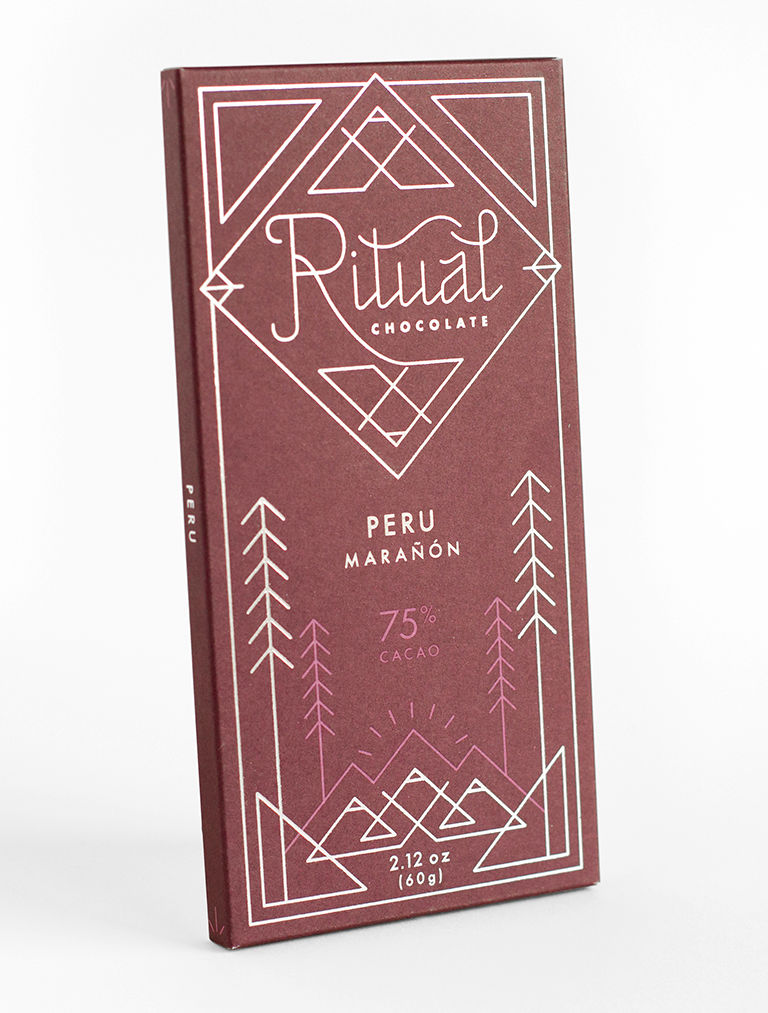
The fruity and floral notes we picked up from that chocolate were unlike anything we ever tried before, and it was an ah-ha moment for us with understanding true flavor potential with great cacao.
A few years later we had the pleasure of meeting Adam and Dan Pearson from Maranon and they were just starting to sell some of their cacao beans. We jumped at the chance, a perfect opportunity to work with the beans that truly inspired us to start our own chocolate making journey!”
Another bar we’ve got our eyes on is Ritual’s Bourbon Barrel-Aged Bar. They soak a blend of their cacao nibs in High West whiskey bourbon barrels for a few months, as Robbie notes, “to impart all the oak, char, smokey and caramel notes from the barrel.”
Ritual then grinds and creates a 75% dark chocolate from those beans.
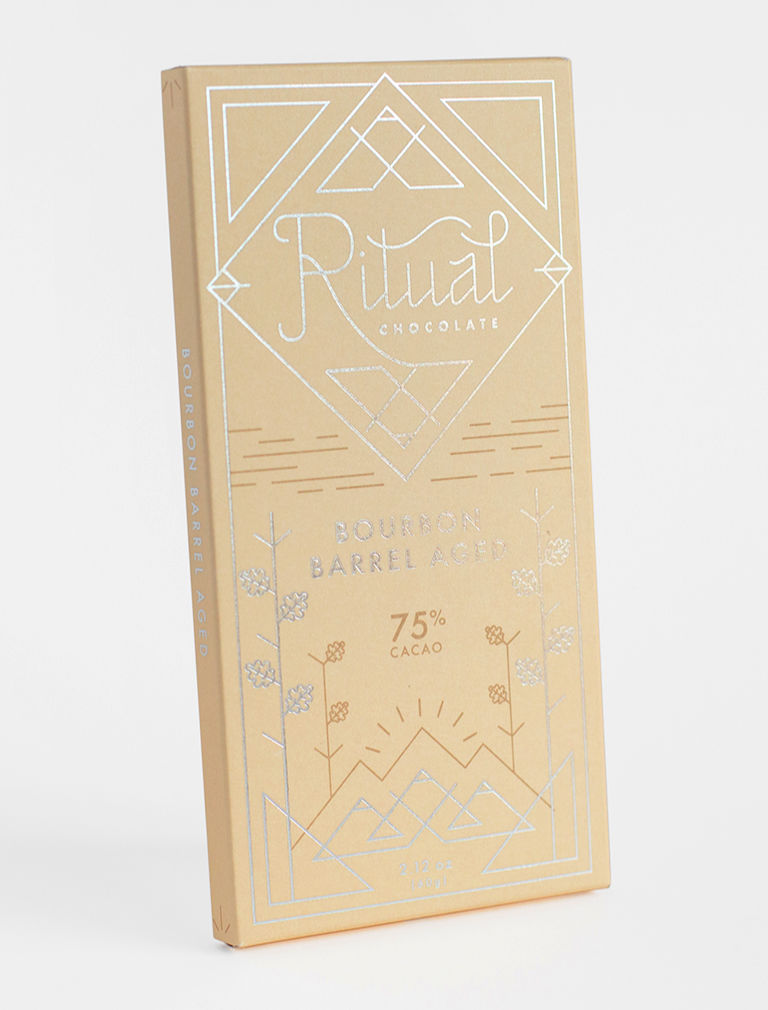
Robbie explains further –
“Barrel aging of wine and whiskey is often used to round out and soften the flavor notes, so we really wanted to see what affect it would have on the finished chocolate.
You get a balanced, smokey chocolate with light caramel, vanilla flavors. It’s a favorite here at Ritual and pairs beautifully with bourbon.”
By now, I’m sure you’re ready to get your hands on as much Ritual Chocolate as you possibly can, and on a side note, Anna and Robbie have pulled in multiple awards for their work as well, including International Chocolate, Academy of Chocolate, Good Food, and Sofi awards.
Congratulations Anna and Robbie — all that hard work did indeed pay off!
Chocolate philosophy + The Road Ahead
With everything this chocolate duo endured to finally reach the peak of their own chocolate mountaintop, a solid chocolate philosophy now guides the two forward into the future. Robbie elaborates on Ritual’s chocolate compass —
“Only buy ultra-high quality cacao. Pay well for that cacao as a reward for the extra effort.
Employ minimal roasting because the cacao already has all the flavor it needs. Obsess over texture with our milling equipment.
Separate particle size refining from conching. These are two different steps for us, while modern-day equipment combines textures processes and the conching process all in the same machine, so neither are done well.
Instead, the roll mill gets the particles nice and small and flat. The conche makes the particles round and develops flavor.”
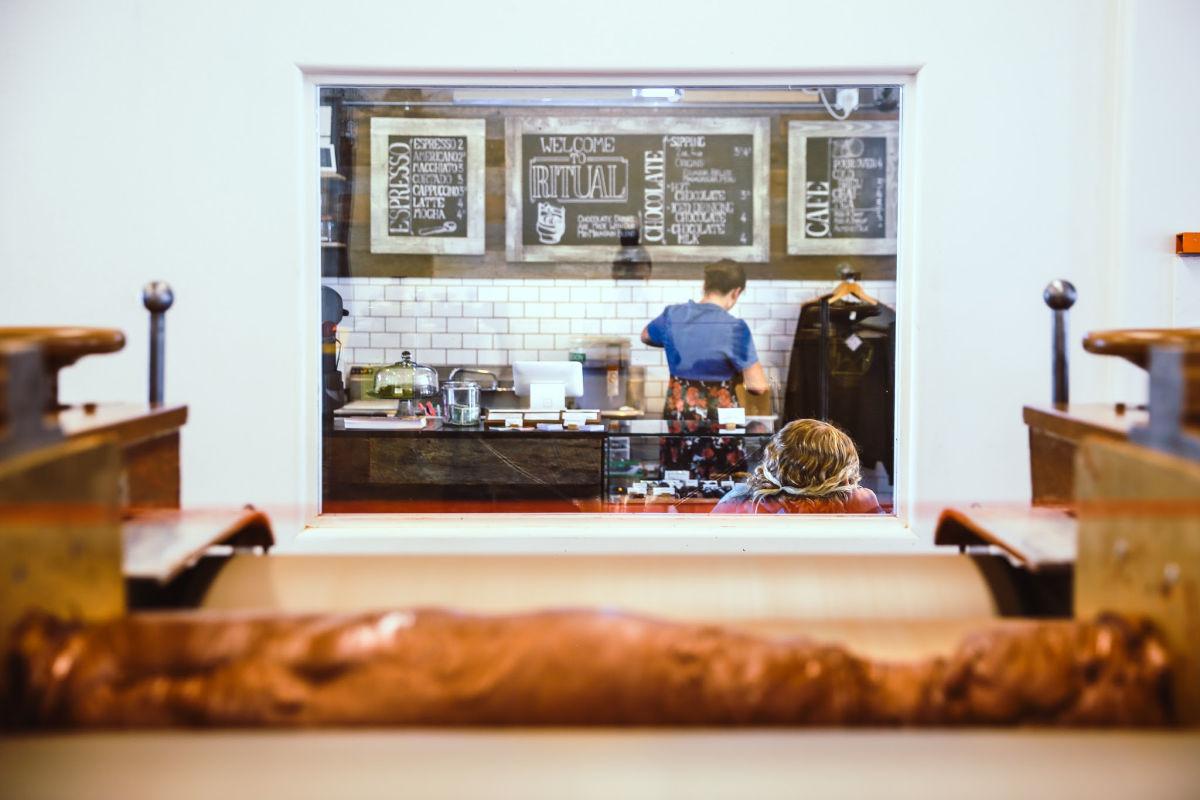
The duo continues to push the craft chocolate envelope, right there in their own little corner of the mountains… appropriately, with a current focus their new Mountain Line, which both Anna and Robbie are really excited about (for good reason, as my tastings of the bars accurately reflected).
“Other than that, we’re always finding ways to improve our products. One little thing we did this year was to start using compostable packaging for our bars.”
Ritual also just invested in new drinking chocolate equipment, so they hope that endeavor helps expand their drinking chocolate offerings.
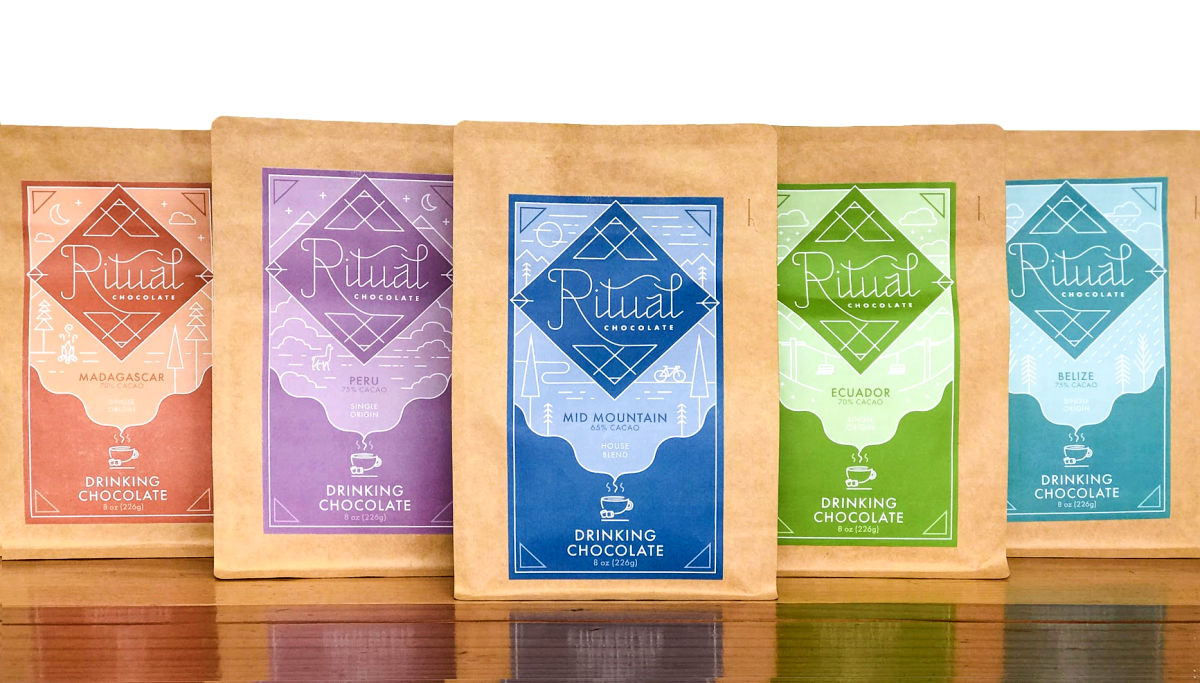
They currently offer four different drinking chocolate varieties, available for wholesale and retail. Although they did send us some in our wonderful summer “chocolate care package” as I liked to call it (see more on that in my Editor’s Corner in the July ’19 issue), it’s staying sealed until the weather turns a little chillier here in Phoenix.
As the holidays near, and the cooler weather prevails, however, I very much look forward to trying Ritual’s drinking chocolate. I’ll make sure to post a note about that in a future Editor’s Corner as well, so keep an eye out.
In the meantime, let’s all keep an eye out for whatever delectable creations Anna and Robbie come up with next. Ritual Chocolate easily won us over, thanks to their generosity, their inspiring openness in sharing all the pitfalls overcome to finally reach chocolate success, and of course, thanks to their incredibly delicious chocolate bars.
Bravo, Ritual Chocolate. Bravo!
To learn more about Ritual Chocolate, CLICK HERE to visit the Ritual website.
Then click the links below to connect with Robbie, Anna and the rest of Ritual Chocolate on social media.
+ PHOTOS BY RITUAL CHOCOLATE


